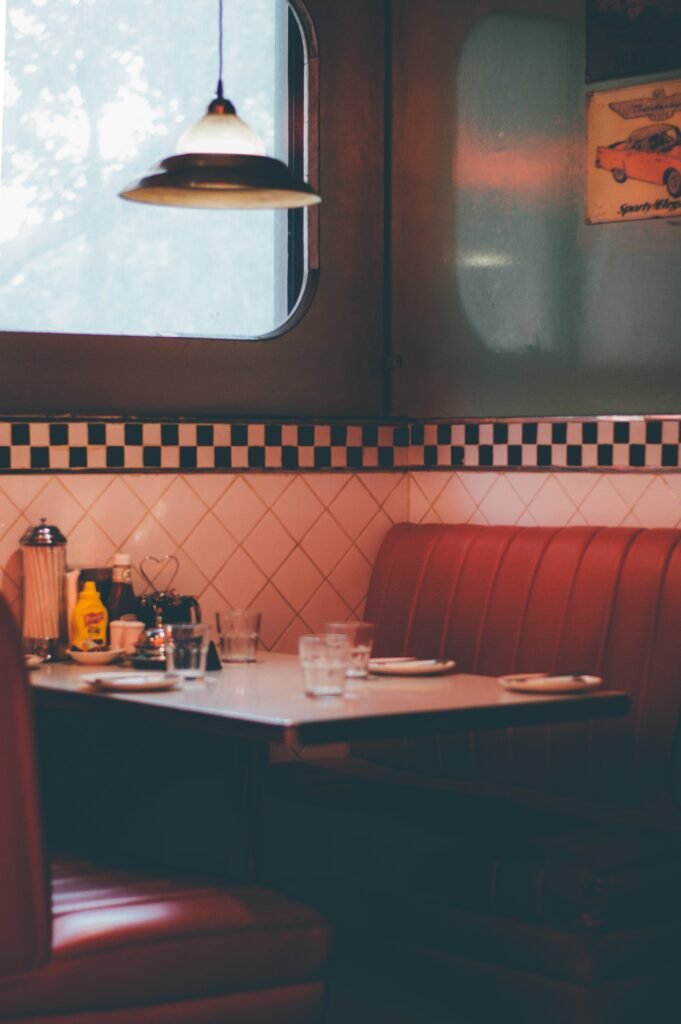
Booths for restaurants are often considered to be a monolith. What this means is that people often assume that there is only one type of booth that restaurants might use. This often stems from a surface level understanding of this type of furniture. While different types of booths might look the same to you, their subtle differences can often be quite profound. They reflect the history of this furniture type and can determine when and where these specific booth types can be used. Many of these differences go beyond pure aesthetics too, and are driven by functionality instead.
If you were to look at historical restaurant booths, there are two types that stand out the most. The first of these two is the V Back. V Backs are a highly iconic class of booths that were one of the first to be introduced in restaurants back in the 1920s. The unique V stitching in the backrest was an embellishment that was quite easy to accomplish, and in those days a minimalist design featuring only solid colors would have been wildly out of place since over the top aesthetics were the norm.
V Backs also had shorter backrests than you might be used to. This was a practical consideration since they came about right after the Great Depression and the restaurant owners that had them made had to cut corners financially wherever they could. Hence, these booth types don’t provide the same level of privacy that modern booths do which is why you might not see them around all that often. What’s more is that the V shaped stitching is not exactly modern, and there are far more prominent embellishments that modern booths tend to opt for.
The era of the V Back was followed by that of the Plain Back. Plain Backs were most prominent in the 50s and 60s when design philosophies like minimalism were starting to take root. It was not uncommon to see plain back booths in certain high end eating establishments, and this trend even persists to the modern day. The lack of embellishments is something that 60s design preferences have in common with more modern approaches to design. This indicates the often cyclical nature of restaurant trends in furniture and shows how trends ebb and flow but rarely ever go away for good.
From the 70s to the 90s, booths took a bit of a nosedive. They receded in popularity for a wide range of reasons, the most prominent of which was the rise of individual or two person dining. Big family affairs at restaurants became somewhat less common during these decades, but that doesn’t mean that booths disappeared completely. Quite on the contrary, booths for restaurants saw the rise of an entirely new design type, though it’s not a design that we think all that highly of due to its rather gaudy and restrictive nature as well as the fact that it is impossible to work with in a modern design setting.
The design that we are referring to is the Fan Back, and it can be a little difficult to understand why it became popular in the first place. The fact that the back forms an arc rather than the straight line means that only the person sitting in the middle would get proper lumbar support. The people on either side of the middle would be forced to deal with an awkward backrest that arches downwards which means that there won’t be any backrest consistency either.
Another thing that makes this such an unpopular booth choice these days is the rather terrible design. The patterns used in this booth look akin to something an elderly grandma might have in her parlor. This is obviously not a design that suits most restaurant requirements, so it’s a bit of a relief that we don’t see it around much anymore.
Then comes a booth style that manages to connect the old with the new in the most remarkable way. If you think that booths can’t work well with a purely modern design philosophy, you clearly don’t know about Bead Boards. This booth type eschews a padded backrest in favor of a slightly slanted wooden board. This gives it a very modern feel, and it helps to replace the easily damaged cushioned backrest with something a lot sturdier.
Bead boards might look uncomfortable, but you would be surprised at just how relaxing they can be. Wood provides excellent lumbar support and this might be the only example of a booth that can genuinely be called chic. This is why so many fine dining eateries have tried using them to great success.
If you want a booth that adheres to steakhouse standards, you might want to go for the button tufted booth. This booth is heavily padded and has tufted buttons in the backrest which give it a luxurious yet sober feel. The sophistication associated with this booth type is something that bead boards can’t compare to, mostly because they offer something that has a heavier, more conservative feel to them than the light airiness of bead boards.
These examples should give you a glimpse into the sheer diversity of booths that are on offer. If your main concern with booths was that they might not suit your needs, you should really think again. There are so many different booth types on offer that pretty much everyone can find the right style for their needs. As you can see, stylistic differences can result in functional differences too, so it’s not just about how they look. However, the way they look tends to matter a lot too, so you shouldn’t ignore this factor when you are selecting the ideal booth type for your eatery.



